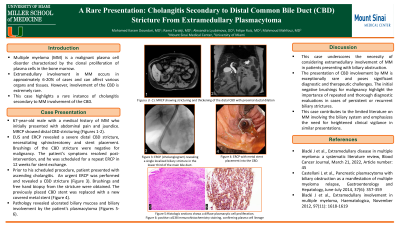Monday Poster Session
Category: Biliary/Pancreas
P1800 - A Rare Presentation: Cholangitis Secondary to Distal Common Bile Duct (CBD) Stricture From Extramedullary Plasmacytoma
Monday, October 28, 2024
10:30 AM - 4:00 PM ET
Location: Exhibit Hall E

Has Audio

Mohamed Karam Douedari, MD
Mount Sinai Medical Center
Miami Beach, FL
Presenting Author(s)
Mohamed Karam Douedari, MD1, Rama Tarakji, MD1, Alexandra Lyubimova, DO1, Felipe Ruiz, MD2, Mahmoud Mahfouz, MD3
1Mount Sinai Medical Center, Miami Beach, FL; 2University of Miami Miller School of Medicine at Jackson Memorial Hospital, Miami, FL; 3University of Miami Miller School of Medicine, Miami, FL
Introduction: Multiple myeloma (MM) is a malignant plasma cell disorder characterized by the clonal proliferation of plasma cells in the bone marrow. Extramedullary involvement in MM occurs in approximately 6-20% of cases and can affect various organs and tissues. However, involvement of the CBD is extremely rare, with only a very few cases reported in the literature. This case report highlights a rare instance of cholangitis secondary to MM involvement of the CBD.
Case Description/Methods: A 67-year-old male with a medical history of multiple myeloma with osseous metastases, on carfilzomib, cyclophosphamide, and dexamethasone (KCd), who initally presented with abdominal pain and jaundice. MRCP showed stricturing of the distal CBD with proximal ductal dilation. EUS and ERCP revealed a severe distal CBD stricture, necessitating sphincterotomy and stent placement. Brushings of the CBD stricture were negative for malignancy. The patient’s symptoms resolved post-intervention, and he was scheduled for a repeat ERCP in 12 weeks for stent exchange. Prior to his scheduled procedure, he presented with a three-day history of fever and abdominal pain. The patient exhibited diffuse abdominal tenderness to palpation and was febrile and hypotensive. Laboratory tests revealed an acute increase in direct bilirubin from 0.6 to 4.7 mg/dL, elevated alkaline phosphatase and transaminases, while lipase was normal. Ascending cholangitis was suspected. An urgent ERCP revealed a single localized CBD stricture. Brushings and free hand biopsy from the stricture were obtained. The previously placed stent was removed, and a new covered metal stent was inserted into the CBD.
Pathology revealed ulcerated biliary mucosa and biliary involvement by the patient's plasmacytoma.
Discussion: This case underscores the necessity of considering extramedullary involvement of MM in patients presenting with biliary obstruction. The presentation of CBD involvement by MM is exceptionally rare and poses significant diagnostic and therapeutic challenges. The initial negative brushings for malignancy highlight the importance of repeated and thorough diagnostic evaluations in cases of persistent or recurrent biliary strictures. This case contributes to the limited literature on MM involving the biliary system and emphasizes the need for heightened clinical vigilance in similar presentations.
Reference:
Bladé J et al., Extramedullary disease in multiple myeloma: a systematic literature review, Blood Cancer Journal, March 21, 2022, Article number: 45

Disclosures:
Mohamed Karam Douedari, MD1, Rama Tarakji, MD1, Alexandra Lyubimova, DO1, Felipe Ruiz, MD2, Mahmoud Mahfouz, MD3. P1800 - A Rare Presentation: Cholangitis Secondary to Distal Common Bile Duct (CBD) Stricture From Extramedullary Plasmacytoma, ACG 2024 Annual Scientific Meeting Abstracts. Philadelphia, PA: American College of Gastroenterology.
1Mount Sinai Medical Center, Miami Beach, FL; 2University of Miami Miller School of Medicine at Jackson Memorial Hospital, Miami, FL; 3University of Miami Miller School of Medicine, Miami, FL
Introduction: Multiple myeloma (MM) is a malignant plasma cell disorder characterized by the clonal proliferation of plasma cells in the bone marrow. Extramedullary involvement in MM occurs in approximately 6-20% of cases and can affect various organs and tissues. However, involvement of the CBD is extremely rare, with only a very few cases reported in the literature. This case report highlights a rare instance of cholangitis secondary to MM involvement of the CBD.
Case Description/Methods: A 67-year-old male with a medical history of multiple myeloma with osseous metastases, on carfilzomib, cyclophosphamide, and dexamethasone (KCd), who initally presented with abdominal pain and jaundice. MRCP showed stricturing of the distal CBD with proximal ductal dilation. EUS and ERCP revealed a severe distal CBD stricture, necessitating sphincterotomy and stent placement. Brushings of the CBD stricture were negative for malignancy. The patient’s symptoms resolved post-intervention, and he was scheduled for a repeat ERCP in 12 weeks for stent exchange. Prior to his scheduled procedure, he presented with a three-day history of fever and abdominal pain. The patient exhibited diffuse abdominal tenderness to palpation and was febrile and hypotensive. Laboratory tests revealed an acute increase in direct bilirubin from 0.6 to 4.7 mg/dL, elevated alkaline phosphatase and transaminases, while lipase was normal. Ascending cholangitis was suspected. An urgent ERCP revealed a single localized CBD stricture. Brushings and free hand biopsy from the stricture were obtained. The previously placed stent was removed, and a new covered metal stent was inserted into the CBD.
Pathology revealed ulcerated biliary mucosa and biliary involvement by the patient's plasmacytoma.
Discussion: This case underscores the necessity of considering extramedullary involvement of MM in patients presenting with biliary obstruction. The presentation of CBD involvement by MM is exceptionally rare and poses significant diagnostic and therapeutic challenges. The initial negative brushings for malignancy highlight the importance of repeated and thorough diagnostic evaluations in cases of persistent or recurrent biliary strictures. This case contributes to the limited literature on MM involving the biliary system and emphasizes the need for heightened clinical vigilance in similar presentations.
Reference:
Bladé J et al., Extramedullary disease in multiple myeloma: a systematic literature review, Blood Cancer Journal, March 21, 2022, Article number: 45

Figure: MRCP showing stricturing and thickening of the distal CBD with proximal ductal dilation (1 and 2). ERCP revealing a single localized biliary stricture in the lower third of the main bile duct (3). ERCP with metal stent placement into the CBD (4). Histologic sections shows a diffuse plasmacytic cell proliferation (5) (H&E; 200x) with positive cd138 (6) (IHC; 200x) immunohistochemistry staining, confirming plasma cell lineage.
Disclosures:
Mohamed Karam Douedari indicated no relevant financial relationships.
Rama Tarakji indicated no relevant financial relationships.
Alexandra Lyubimova indicated no relevant financial relationships.
Felipe Ruiz indicated no relevant financial relationships.
Mahmoud Mahfouz indicated no relevant financial relationships.
Mohamed Karam Douedari, MD1, Rama Tarakji, MD1, Alexandra Lyubimova, DO1, Felipe Ruiz, MD2, Mahmoud Mahfouz, MD3. P1800 - A Rare Presentation: Cholangitis Secondary to Distal Common Bile Duct (CBD) Stricture From Extramedullary Plasmacytoma, ACG 2024 Annual Scientific Meeting Abstracts. Philadelphia, PA: American College of Gastroenterology.
